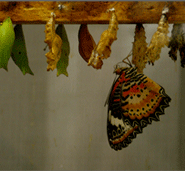What is this realm? Inside an oblong cubicle the white walls are blanketed with shadows of images. Shadows that are white, shadows that are grey, shadows that overlap and swing between the exalted and the mundane. A realm where positive areas mingle with negative spaces allowing them to seep between images that split in halves. Images charged with an intensity of Munch. Images projected from quaint wooden trolleys with large wooden wheels – each nesting an enlarger.
I was befuddled as I entered the serenity of Praneet Soi’s solo show, “Drawing Machine”, in and displaced by the whistling traffic guards, snarls, beeping red, yellow and green lights, overcrowded streets, sweat and snags in the flap gates of the city metro that I was amidst only minutes ago.
Shadows.
They extend the limits of the framed
Images attain a new scale, mingle
With the space where they fall.
Shadows: they reciprocate.
The idea of transforming the known is a penchant for every creative mind. It wants to alter and probe. It wants to reign and regulate the unreachable. Like the prehistoric cave painter who portrayed the indomitable mammoths and bison, only to overpower them. Our artist has that childlike urge to alter the known.
His drawings – rendered by overlapping gestures caught in different moments of friends, acquaintances, stray dogs or static city sky-rises – on A4 size transparent OHP sheets (silk-screened/ digitally printed/ manually drawn) are placed on enlargers that project these images on the gallery walls and alter their positions. The characters alter their purposes. The walls change their characters. The enlarged projections of the images cover the walls like shadowy murals, subverting scale; fleeting, changing each time an onlooker removes the previous sheet and places a new one of his choice.
One of the rooms has the same drawings projected on the walls via an enlarger. The images/drawings are first drawn out or printed on OSP sheets which the onlookers can alter/replace and move the wooden machines on which the enlargers are placed. The result produces a theatrical environment within the room. An interactive one too, where each time an individual, other than the artist can bring about a change in the whole ambience, and engage in the act of creation, or recreation, as it were.
By transgressing a dry psychological idea of drawing on a two-dimensional plane, the artist surpasses a ‘solution’ and subsequently prevents himself from arriving at the end of his journey. He adapts to accidental situations, alters, like sketches precede a final painting: opens, adjusts constantly to newer avenues.
Soi’s images, often acutely foreshortened, or viewed with the ant’s and bird’s eye are woven into a complex mass, deliberately coalescing. The eyes thus search for the hidden forms, as eyes do.
The artist plays with this natural instinct. He lures, controls, guides. He dodges, seduces, tricks and transforms ‘realization’. He allows negatives areas to become part of his subjects. He imagines beyond traditions. The strong graphic quality creates a tension in contrast with the otherwise blank picture plane.
Images and spaces permeate each other, blurring the fuzzy lines between them, engendering a whole new gamut where each is no longer a separate entity in a four walled room, but a nebulous interplay of shadows, walls and objects. The creation—by both artist and viewer—of an insular world in a city traversed by screeches and snarls.
The humans, the geometry of the buildings with a mesh of striations traversing each other, the part of a body – hands, heads, faces, eyes – all change roles. Space gives way to space.
Oindrilla Maity is a writer and curator based in Kolkata.
Praneet Soi was born in 1971 and is from Kolkata, traveling oft between Kolkata and Amsterdam.
Editor's Note.
I was about 9 years old—a 3x3 cube—and my school had a class, an hour a week, called 'Value Education'. Our teacher gave us an A4 sheet of paper, split into 12 boxes. Each box had a patternless constellation of dots. Our task was simply to create a square, a rectangle or a triangle within each box, without leaving a single dot astray.
While I connected the dots into stars and baby elephants with stubbed noses and large antennae, my peers were coerced—I say coerced because it was a time when lines did not come naturally to us, when we didn't feel obliged to color inside trees and they didn't need to be green—into following the structure.
Read MoreWhile I connected the dots into stars and baby elephants with stubbed noses and large antennae, my peers were coerced—I say coerced because it was a time when lines did not come naturally to us, when we didn't feel obliged to color inside trees and they didn't need to be green—into following the structure.
Also in this issue
Illusion: Seeing Beyond Seeing
Meaning: In Search of Significance.
Melody: A Different Tune
Rhythm: Ordering Time









